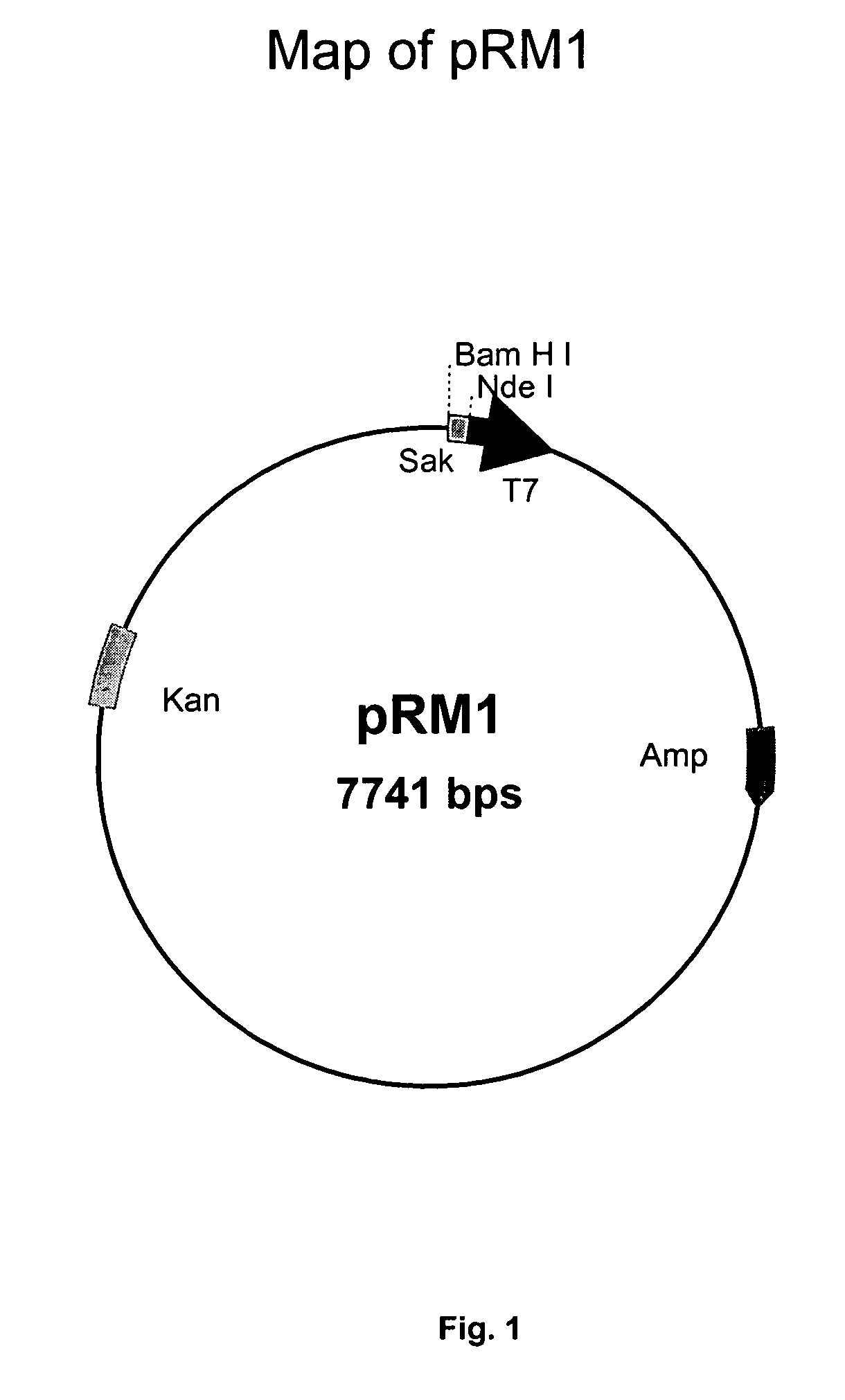Method for oxygen regulated production of recombinant staphylokinase
a technology of recombinant staphylokinase and oxygen regulation, applied in the field of new products, can solve the problems of high cost of systems used for large-scale production of this protein, difficult production of intact, biologically active sak from bacterial expression systems, etc., and achieve the effect of economic viability of the overall system and efficient and economical
- Summary
- Abstract
- Description
- Claims
- Application Information
AI Technical Summary
Benefits of technology
Problems solved by technology
Method used
Image
Examples
example 1
Construction of Expression System for the Production of intracellular Staphylokinase
[0086]The overall process for the construction of expression system for the production of Staphylokinase basically involved following three main steps:
[0087]Step 1: In order to construct a recombinant plasmid able to produce native-like recombinant SAK, total genomic DNA was isolated from a locally isolated species of Staphylococcus aureus (designated as SAK-11) using standard DNA isolation procedure. First SAK encoding DNA sequence was amplified through PCR using following set of oligonucleotide primers
[0088]
SAK-1 primer:5′-GATTGTAGCCATATGTCAAGTTCATTCGACAAAGGAA-3′(37-mer).SAK-2 primer:5′-CGGCTACTGGATCCTCCACTTTTATCCAAACTGATTT-3′(37-mer).
[0089]The PCR was carried out using the DNA template of S. aureus and SAK-1 and SAK-2 primers in 100 ul reaction mixture carrying 10 nanograms of template DNA, 20 picomoles of SAK-1 and SAK2, 2.5 units of Vent DNA polymerase (NEB) and 20 μL of each dNTPs and 10 μl of ...
example 2
Production of Recombinant Staphylokinase from E. coli
[0096]For the production of recombinant staphylokinase in E. coli using recombinant plasmid, pOXYSAK (FIG. 8), glycerol stocks of E. coli JM109 strain harboring plasmid, pOXYSAK-1, maintained at −70° C. were used to prepare a seed culture by inoculating freshly thawed glycerol stock (approx. 100 ul) into a 500 ml flask carrying 100 ml of LB medium with 100 μg / ml of ampicillin. The flask was incubated at 37° C. with shaking on a rotary shaker at 200 rpm for 16-18 h. This cell culture of E. coli was used to seed four 2 Liter Erlenmyer flasks each containing 500 ml of the same medium (LB containing 100 μg / ml ampicillin) using 5% of the inoculum. The flasks were incubated at 37° C. with shaking at 200 rpm until the absorbance of the culture at 600 nm reached to 0.8 (around 5-6 h after inoculation). Thereafter, shaking of the culture was changed to 50 rpm and the culture was allowed to grow for another 6-8 h to build up the SAK protei...
example 3
Recovery of Recombinant SAK from E. coli, Purification and Characterization of its Biological Activity
[0097]The 6-8 h grown E. coli cells, carrying pOXYSAK (as mentioned in Example 2), were harvested by spinning them down by centrifugation at 6000×g in a GS-3 rotor (Sorvall) for 30 min at 4° C. The supernatants were discarded and the cell pellet was resuspended in 50 ml of Tris.Cl buffer and lysed either by sonication or chemical lysis using 6M guanidium hydrochloride and 20 mM sodium phosphate buffer, pH 7.2. The cell lysate was centrifuged at 6000×g at 4° C. for 15 min and clear lysates were diluted four fold with distilled water and thereafter applied at room temperature to a 10×32 cm column of SP-sepharose at a flow rate of 1 liter per hour. The column was washed with 0.1M phosphate buffer, pH 6.2 and eluted with a gradient of 0.1 to 0.5M NaCl. The SAK containing fraction was checked by spot test by mixing 1 ul of fraction with 1 μl of human plasminogen (100 mg / ml) and 1 μl of c...
PUM
| Property | Measurement | Unit |
|---|---|---|
| pH | aaaaa | aaaaa |
| temperature | aaaaa | aaaaa |
| flow rate | aaaaa | aaaaa |
Abstract
Description
Claims
Application Information
 Login to View More
Login to View More - R&D
- Intellectual Property
- Life Sciences
- Materials
- Tech Scout
- Unparalleled Data Quality
- Higher Quality Content
- 60% Fewer Hallucinations
Browse by: Latest US Patents, China's latest patents, Technical Efficacy Thesaurus, Application Domain, Technology Topic, Popular Technical Reports.
© 2025 PatSnap. All rights reserved.Legal|Privacy policy|Modern Slavery Act Transparency Statement|Sitemap|About US| Contact US: help@patsnap.com



